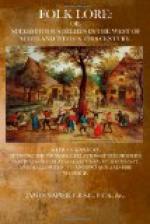Grian chnox (Greenock), means Knoll of the Sun.
Granton, means Sun’s Fire.
Premising, therefore, that sun-worship and Druidical customs form the original base of all our old national festivals, we will now direct attention to the great festival of
YULE.
The term Yule was the name given to the festival of the winter solstice by our northern invaders, and means the Festival of the Sun. One of the names by which the Scandinavians designated the sun was Julvatter, meaning Yule-father or Sun-father. In Saxon the festival was called Gehul, meaning Sun-feast. In Danish it is Juul; in Swedish Oel. Chambers supposes that the name is from a root word meaning wheel. We have no trace of the name by which the Druids knew this feast. The Rev. Mr. Smiddy in his book on Druidism in Ireland, says, “Their great feast was that called in the Irish tongue Nuadhulig, meaning new all heal, or new mistletoe. When the day came the priests assembled outside the town, and the people gathered shouting all heal. Then began a solemn procession into the forests in search of the mistletoe growing on the favourite oak. When found, the priests ascended the tree, and cut down the divine plant with a golden knife, which was secured below upon a linen cloth of spotless white; two white bulls were then conducted to the spot for the occasion, and there sacrificed to the sun god. The plant was then brought home with shouts of joy, mingled with prayers and hymns, and then followed a general religious feast, and afterwards scenes of boisterous merriment, to which all were admitted.”
From other accounts of this sun feast at the winter solstice in this country, we are given to understand that besides white bulls there were also human victims offered in sacrifice. The mistletoe gathered was divided among the people, who hung the sprays over their doorways as a protection from evil influences, and as a propitiation to the sylvan deities, and to form sheltering places for those fairy beings during the frosts. The day after the sacrifices was kept as a day of rejoicing, neighbours visited each other with gifts, and with expressions of good will.
From all I have been able to gather respecting this great sun feast at the winter solstice as it was celebrated in this country in prehistoric times, I am of opinion that the sacrifices were offered to the sun on the shortest day, to propitiate his return, and that that day was a day of great solemnity, but that the day following when the mistletoe was distributed and hung up, was a day of rejoicing and thanksgiving on this account, that the sacrifices had proved acceptable and efficacious, the sun having returned again to begin his course for another year, and this day was the first day of the year.




